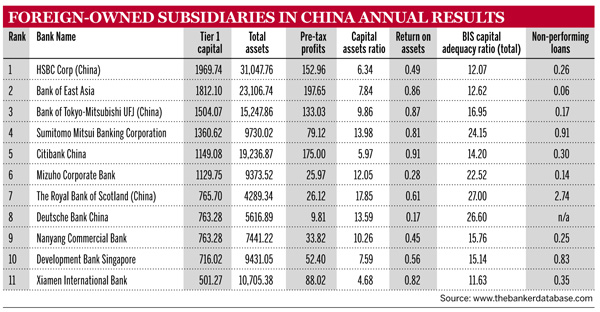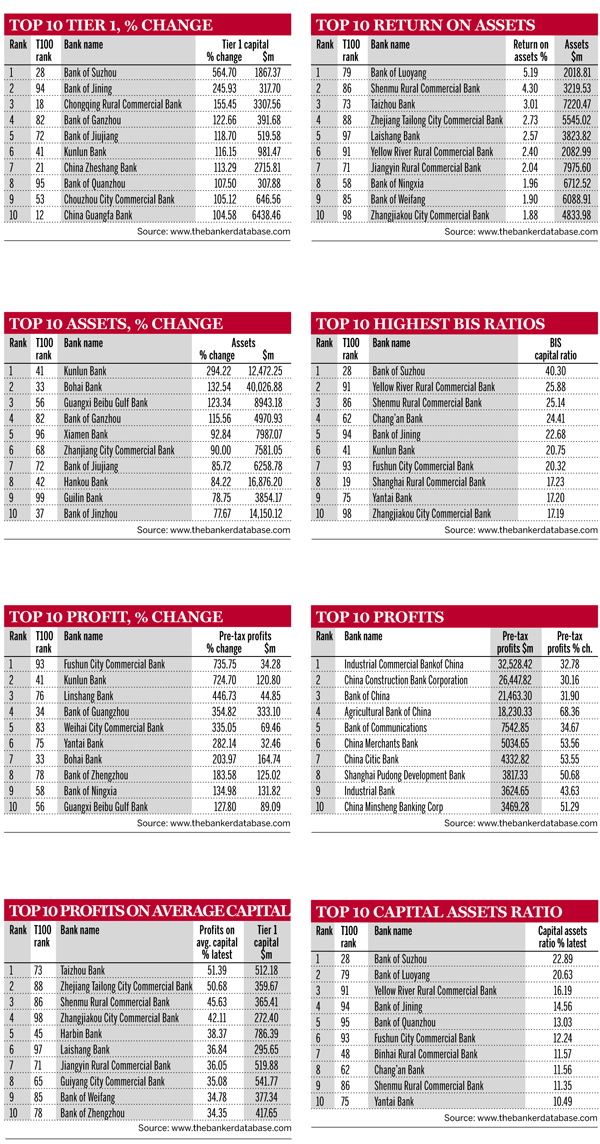China's banking success story spreads across the country
The growth of China's banking sector continues unabated, with banks the length and breadth of the country, small and large, turning in impressive performances in The Banker's Top 100 Chinese Banks ranking.
China’s biggest banks are increasing their assault on the global rankings, but when it comes to growth, it is the banks from outside the big two cities – Beijing and Shanghai – that are displaying the most dramatic changes in The Banker's top 100 Chinese banks rankings.
The four big state-owned banks – Industrial Commercial Bank of China (ICBC), China Construction Bank (CCB), Bank of China (BoC) and Agricultural Bank of China (ABC) – take the top four places in the ranking. And on the world stage they are climbing up the listings, with three of the four banks now in the global top 10, with the fourth, ABC, not far behind in 14th place, in terms of Tier 1 capital.
The big four
At the top end of the top 100 Chinese banks table, the big four are battling to improve their positions. Among the top four Chinese banks, the only change was to the second and third position, with CCB rising to second place by knocking BoC down into third. The rankings of the top four – measured by Tier 1 capital – were mirrored in the assets ranking.
The big four state-owned banks were also the most profitable Chinese banks. ICBC’s pre-tax profits were $32.53bn, CCB’s $26.45bn, BoC’s $21.46bn, and ABC's $18.23bn. ICBC’s and CCB’s pre-tax profits came in as first and second in the world in The Banker’s Top 1000 World Banks ranking.
The change in profit growth was also sizeable for each of these four banks, with ICBC’s growth in pre-tax profits standing at 32.78%, CCB’s at 30.16%, BoC’s at 31.90% and ABC's at 68.36%. While the 68.36% increase in ABC’s pre-tax profits might seem high, it pales in comparison to banks from other regions in China.
The figures from the top 10 profit change table show some dramatic results, with Fushun City Commercial Bank posting a 735.75% increase in its pre-tax profits, which stand at $34.28m. Kunlun Bank, which ranks second in terms of the percentage change on profits, recorded a 724.7% increase in its pre-tax profits. Linshang Bank is in third place on this table, recording a relatively lower – although still high – growth rate of 446.73% and pre-tax profits of $44.85m.
Smaller banks snatch profits
Profits on average capital were much higher in the smaller banks, while it was the big four that were posting the biggest sums. The profits on average capital were high, at 51.39% for Taizhou Bank, 50.68% for Zhejiang Tailong City Commercial Bank and 45.63% for Shenmu Rural Commerical Bank, which rank much lower down the list in terms of Tier 1 capital at 73, 88 and 86, respectively.
Much of the impressive growth came from the banks at the lower end of the top 100 rankings. With return on assets (ROA), for example, the highest figures did not come from the big four. ICBC’s figure of 1.6% placed the bank 24th on the ROA list. The top ranking for return on assets was the Bank of Luoyang, which ranks 79 on the China top 100 list. The bank has assets of $2.02bn and its ROA was 5.19%. This was followed by Shenmu Rural Commercial Bank with assets of $3.22bn and ROA of 4.3%. In third place on the table is Taizhou Bank with 3.01% ROA, and assets of $7.22bn.
Beyond Beijing
Banks from other locations – outside of Beijing and Shanghai – are another interesting feature on the tables, posting as they do the most dramatic growth figures. In terms of the Tier 1 capital rankings, there is also a mix of cities featured in the listings, which shows the growing importance of other areas in China. In terms of asset growth, banks from outside the big two metropolises feature heavily again. And they do not just score highly in terms of the rankings of the Chinese banks; they post the highest asset growth in the world. Six Chinese banks feature in the global top 25 for asset growth: Kunlun Bank, Bohai Bank, Guangxi Beibu Gulf Bank, Bank of Ganzhou, Xiamen Bank and Zhanjiang City Commercial Bank.
Kunlun Bank tops both the global and the Chinese list for asset growth. The bank witnessed a 294.22% change on its assets, which now stand at $12.47bn. Bohai Bank ranks third in the world, and second in China, and posted an increase of 132.54% on its assets. Kunlun Bank is notable because it features on many of the top tables of the top 100 Chinese banks. Aside from topping the lists for rise in assets and profits, the bank also features in the top 10 for highest BIS ratio, where, with a BIS capital ratio of 20.75%, it stands in sixth place nationally.
Bank of Suzhou also featured in a number of the top 10 tables for the Chinese banks. It is most noticeable for its increase in Tier 1 capital, with a 564.70% rise. It now has a Tier 1 capital of $1.87bn, which places it 28th in the Top 100 ranking. The bank also tops the top 10 highest BIS ratios in China, with a BIS capital ratio of 40.30%, and it tops the capital assets ratio list, with a CAR of 22.89%.
Foreign subsidiaries
In terms of Tier 1 capital, Bank of Suzhou ranks 28th out of the Chinese banks. Many of the foreign players may eye such a position with envy as the size of their foreign-owned subsidiaries remains dwarfed by the local Chinese banks. HSBC Corp, which ranks top of the foreign players in China, has Tier 1 capital of $1.97bn, which if it was in the same list as the local Chinese banks would place it between Huishang Bank and Beijing Rural Commercial Bank, which are ranked 25th and 26th, respectively.
In terms of assets, HSBC would rank 30th, with assets of $31.05bn. As well as being overshadowed by the large state banks, the foreign banks are not scoring particularly highly in terms of the return on the assets that they do have in China.
For all the foreign subsidiaries, the return on assets is below 1%, compared to the highest scoring figure of 5.19% by Bank of Luoyang. The ROA of 0.28% by Mizuho Corporate Bank, a subsidiary of the Japanese financial operator, is the same as Huarong Xiangjiang Bank, which scores 100th in terms of ROA with the same figure. Deutsche Bank China scores even lower with an ROA of 0.17%, which is lower than any of the local Chinese banks that are featured in the top 100 rankings.




